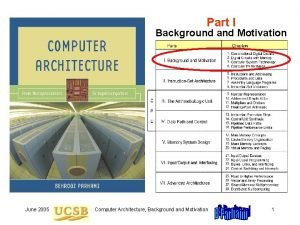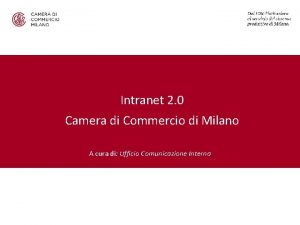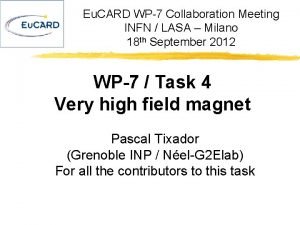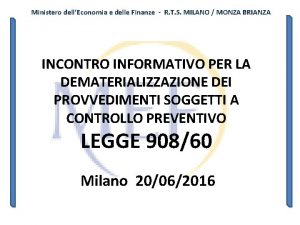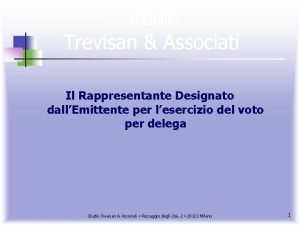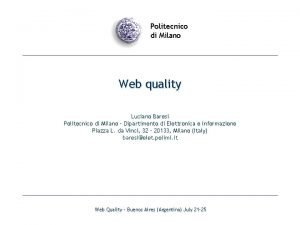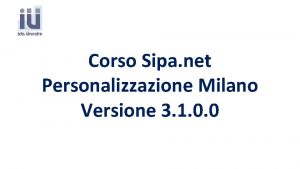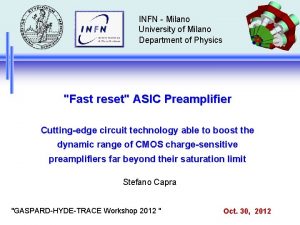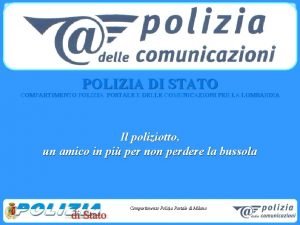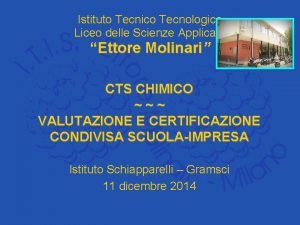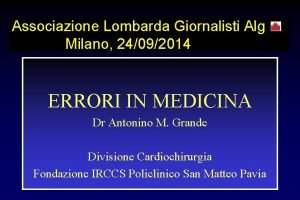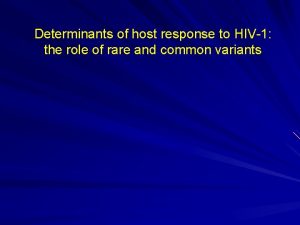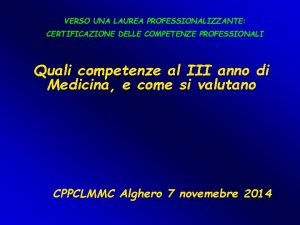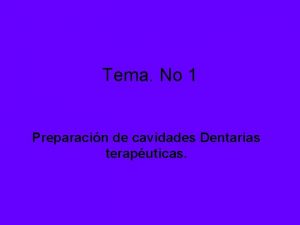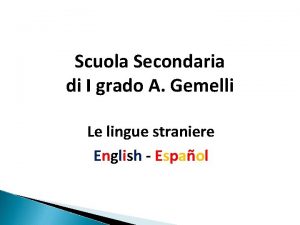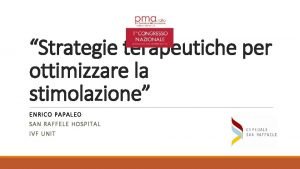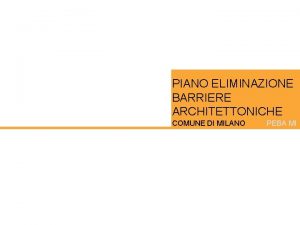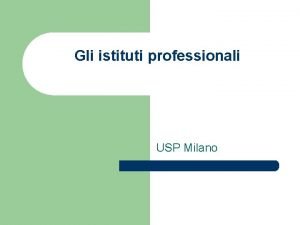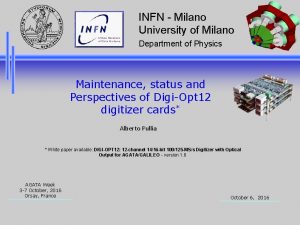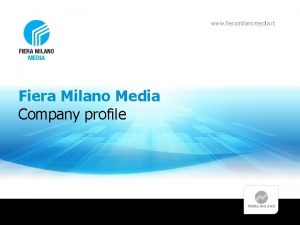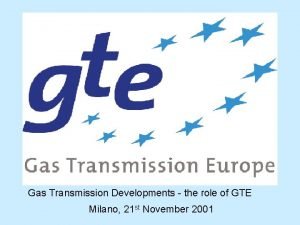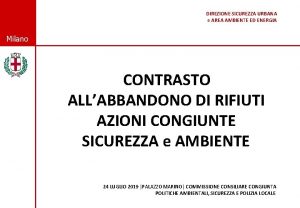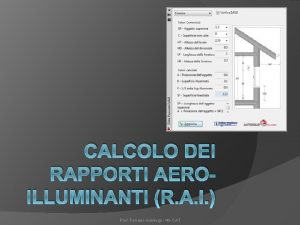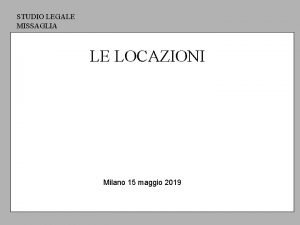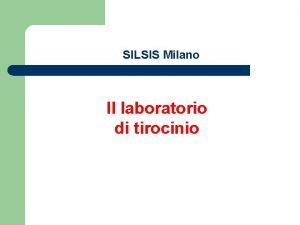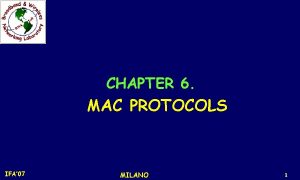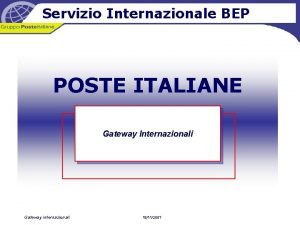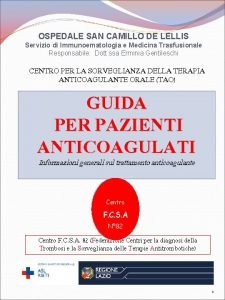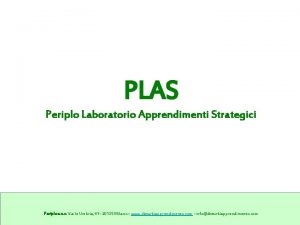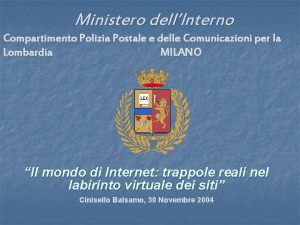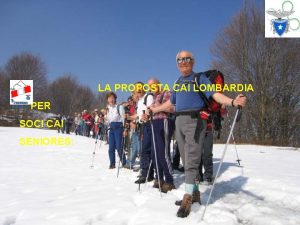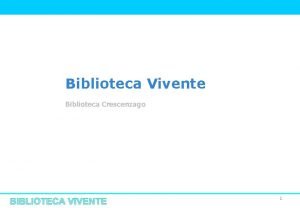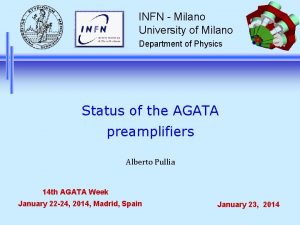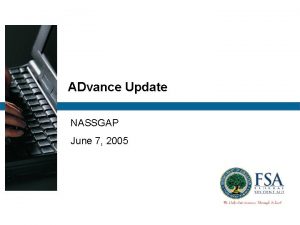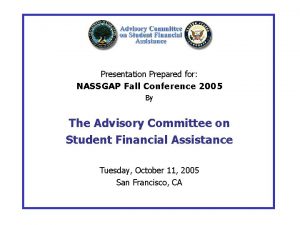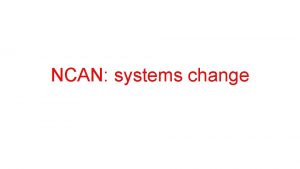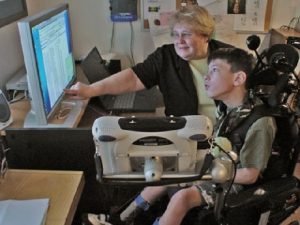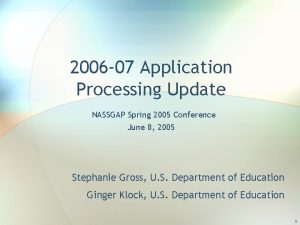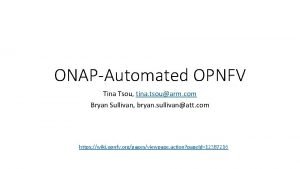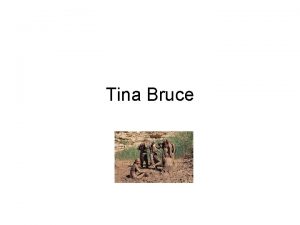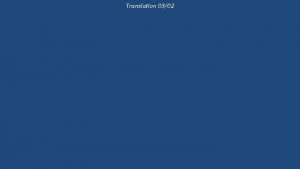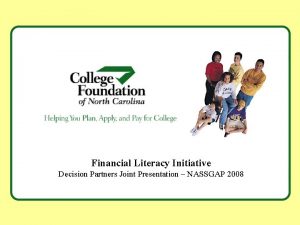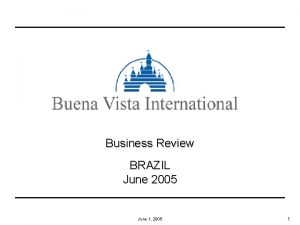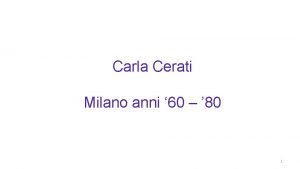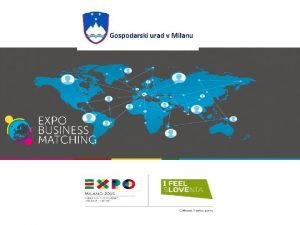NASSGAP Presentation June 8 2005 Tina Milano NCAN


























































- Slides: 58

NASSGAP Presentation June 8, 2005 Tina Milano NCAN Executive Director

What is NCAN? • Association of 138 college access programs, centers, statewide networks and supporting members • Active in 37 states and the District of Columbia • Programs and Centers are communitybased, privately funded • Statewide networks are supported by public/private partnerships

What Is a College Access Program? • Community or state-based nonprofit organization • Created to help financially disadvantaged individuals learn about, enroll in, pay for and be successful in college • Primary funding is from private sources

Statewide Web Portal Information & Referral Statewide Network Community-based Classic College Resource Centers Access Programs

Why Are College Access Programs Needed?

st 21 Century Challenges • The U. S. ranks 13 th among developed nations in educational attainment (percentage of adults with college degrees) • The college participation gaps between affluent and poor students, and between white and minority students, are widening • College costs are climbing, and unmet need is rising for low-income students • The number of young men enrolling in college is much too low.

st 21 Century Challenges • College costs are rising, and unmet need is highest for disadvantaged students • Over a working career, college graduates earn 73% more than high school graduates

America’s High Schools Are Not Meeting the Challenge (NGA-Sponsored National Summit, 2005) • Only 71% graduate from HS • Only 50% US black & Latino HS students graduate • Students are graduating from HS without the skills necessary for success in college or the workforce

National Summit on Education Included a keynote by Bill Gates who described the American high school as "obsolete. “

"By obsolete, I mean that our high schools -- even when they're working exactly as designed -- cannot teach our kids what they need to know today. Training the workforce of tomorrow with the high schools of today is like trying to teach kids about today's computers on a 50 year-old mainframe. It's the wrong tool for the times. “ Bill Gates

The Student Pipeline in the U. S. For every 50 Ninth Graders Source: NCES Common Core Data, WICHE High School Graduates, ACT Institutional Survey, NCES-IPED Graduation Rate Survey 2002

The Student Pipeline in the U. S. 34 Graduate from High School Source: NCES Common Core Data, WICHE High School Graduates, ACT Institutional Survey, NCES-IPED Graduation Rate Survey

The Student Pipeline in the U. S. 20 Enter College Source: NCES Common Core Data, WICHE High School Graduates, ACT Institutional Survey, NCES-IPED Graduation Rate Survey

The Student Pipeline in the U. S. 13. 5 Are Still Enrolled Sophomore Year Source: NCES Common Core Data, WICHE High School Graduates, ACT Institutional Survey, NCES-IPED Graduation Rate Survey

The Student Pipeline in the U. S. 9 Graduate From College (Within 150% Time) Source: NCES Common Core Data, WICHE High School Graduates, ACT Institutional Survey, NCES-IPED Graduation Rate Survey

Challenges -- The 4 A s q Aspiration q Academic Preparation q Availability q Affordability

1. Aspiration § § § § Weak support for higher education Low socioeconomic status Negative attitudes & beliefs Lack of parental involvement Lack of info. about price and benefits of college Lack of financial aid info. Lack of success in K-12 Low expectations from teachers Source: The Ohio Board of Regents, T. Rudd, Sept. 2002

Is Information a Barrier? • Information about financial aid matters. • The more a young adult knows about financial aid, the more likely she is to attend college. • Nearly half of all parents wish they had more information about how to pay for college. • Those who need financial aid the most, understand it the least.

College Knowledge The report’s main findings are: • College-preparatory information and guidance are major components in realizing college aspirations. • Students traditionally underrepresented in higher education do not naturally possess “college knowledge. ” College Knowledge: Addressing Information Barriers to College, Joel H. Vargas, Ed. D. , Published by The Education Resources Institute (TERI)

College Knowledge • The knowledge gap for underrepresented students is exacerbated by their limited access to technology • Finally, research suggests that interventions focused on providing information and guidance about college to underrepresented students and families can supply them with the “college knowledge” they sorely need. College Knowledge: Addressing Information Barriers to College, Joel H. Vargas, Ed. D. , Published by The Education Resources Institute (TERI)

Low-Income Students Attend Postsecondary at Lower Rates 2001 by The Education Trust, Inc. Source: NELS: 88, Second (1992) and Third Follow up (1994); in, USDOE, NCES Condition of Education 1997 p. 64

2. Academic Preparation Low expectations from teachers Lack of parental involvement Lack of academic content standards Inadequate teacher preparation K-12 and higher education are largely divorced from one another Source: The Ohio Board of Regents, T. Rudd, Sept. 2002

2. Academic Preparation “The continued disconnect between K -12 and higher education means that a student may complete the curricular requirements to graduate from high school without satisfying the requirements to enroll in college. ” Laura Perna, U. of Md.

2. Academic Preparation • High schools remain unchanged, despite dramatic transformation in the economy and in the educational expectations for well-paying jobs that can support families. Source: Ready for Tomorrow, Helping All Students Achieve Secondary & Postsecondary Success, A Guide for Governors, Written by Richard Kazis, Hilary Pennington, Kristin D. Conklin, 2003.

3. Affordability § § § Lack of info about financial aid Lack of info about price of college Price of college Declining value of Fed. Pell Grants Reliance on student loans Source: The Ohio Board of Regents, T. Rudd, Sept. 2002

College is Expensive $20 thousand 16 12 Four-year private 8 4 Four-year public ’ 72 - ’ 77 - ’ 82 - ’ 87’ ’ 92 - ’ 97 - ’ 02 ’ 73 ’ 78 ’ 83 ’ 88 ’ 93 ’ 98 ‘ 03 New York Times January 28, 2003

Percent of Family Income Needed to Pay for College – Minus Financial Aid (2000 -01 data) At Community Colleges At Public 4 -Year Institutions Population with the Lowest Income 39% 50% Population with Lower-Middle Income 18% 23% Population with Middle Income 12% 15% Population with Upper-Middle Income 8% 10% Population with the Highest Income 5% 6% Overall Average 16% 21% Income Quintile

Average Unmet Need 1999 - 2000 4 -year public is $4, 818 2 -year public is $4, 495 4 -year private is $8, 257 SOURCE: U. S. Department of Education, National Center for Education Statistics, 19992000 National Postsecondary Student Aid Study (NPSAS: 2000).

Is Information about Financial Aid Really a Barrier? • Information about financial aid matters. • The more a young adult knows about financial aid, the more likely she is to attend college. • Nearly half of all parents wish they had more information about how to pay for college. • Those who need financial aid the most, understand it the least.

“I worked my way through college…” 55 hrs 22 hrs

4. Availability § § § Desired college program not available Lack of info about distance learning opportunities Lack of technical skills to participate in distance learning Programs not offered at times that meet individual needs No transportation (esp. for rural students) Source: The Ohio Board of Regents, T. Rudd, Sept. 2002

Our Response Meeting the 21 st Century Challenge will take measures that are BOLD and PROVEN: Creating Statewide College Access Networks & Community-Based College Access Programs

What Does NCAN Do? • Improve access to and success in higher education • Focus on low-income, underrepresented, and firstgeneration students • Create and help sustain a network of state and local college access programs that provide counseling, advice, and financial assistance (last-dollar scholarships) to students in their schools or neighborhood centers

How Are We Expanding College Access Nationwide Grant Project Funded by Lumina Foundation for Education Goals – Phase I • Reach 125, 000 new underserved students • Establish at least 12 statewide networks • Establish 45 community based initiatives

Statewide Web Portal Information & Referral Statewide Network Community-based Classic College Resource Centers Access Programs

Classic Program – Key Components • Community Supported Non-profit • Created to Help Financially Disadvantaged Individuals Learn About, Enroll in and Pay for College • Provides One-on-one Advising and Last Dollar Grants for Education Beyond H. S. • Primary Funding Is From Private Sources in the Community—Individuals, Corporations, Foundations

Classic Programs q. Financial Aid/College Admissions Counseling (on-site in schools) q. FAFSA Preparation and Submission q. Fee payments ACT/SAT, etc. q. College Application Fees, Room Deposits q. Last Dollar Grants q. Student Advocacy with regard to Colleges and Universities

Classic Programs q. Middle School Programs—clubs, college visits, career counseling q. Parental Engagement q. Retention Programs q. Non-traditional counseling and scholarship programs q. Scholarships for 4 -year, 2 -year and certificate programs

Classic Programs Exist In: • Washington DC • Philadelphia • Baltimore • Chicago • Los Angeles • Columbus • Boston • Cleveland • Norfolk

Resource Center – Key Components • Providing College Access Information through Web-based information, personal counseling & other Resources • Venues Include Libraries, Community Centers, Malls

Resource Centers Currently Operating In: • Boston • Charlotte • Washington, DC • Milwaukee • San Francisco • Philadelphia • Chattanooga • Seattle • Burlington • Portland, OR • Lincoln, NE

Information & Referral and Web Portal Key Components • Broad-based Information Campaign Direct Mail Newsletters Publications • Internet-based Resources (Portal) • Free Telephone Hotline

Information & Referral or Portal Systems Currently Operating In: • Indiana – (formerly ICPAC) • Alaska – Alask. Advantage • North Carolina – CFNC

Don’t guidance counselors provide enough information? Ratio of Secondary School Counselors to Students in: United States 1: 407 Arkansas 1: 694 South Dakota 1: 500 Arizona 1: 590

Statewide Access Networks q. Ohio q. Virginia q. Montana q. Florida * * Maine Minnesota Maryland New Mexico

Do These Programs Work? YES Cleveland -- poorest city --budget cuts in schools– no social workers 84% of students retained 72% graduated within 6 years $7, 000 Budget

Statewide Access Networks

Benefits of College Access Programs • Increasing college-going rates • Increasing retention and graduation of students & adults in postsecondary education • Increased community or statewide educational attainment

Benefits of College Access Programs • Economic Enhancement: lower unemployment, higher earnings, higher tax revenues • Social Enhancement: improvement in quality of life (health, volunteering, voting)

Getting Off the Ground q Nationwide Research on Places Most Likely to Benefit (top states—top cities q Gap Analysis (Too little vs. Too much in some places) q. Community/State Inventory & Readiness Assessment q One-on-One Visits with Key Stakeholders (Feasibility Study) q. Convening Potential Stakeholders

Getting Off the Ground (cont. ) q Cost-Benefit Analysis q Technical Assistance/Consultation q Building Blocks: NCAN Website q Guidebooks for Start Ups q Marketing Materials q Data Collection & Evaluation

Cost-Benefit Analysis: Projected Impact of College Access


GUIDEBOOKS


What Have We Learned? • Champions are crucial—need missionaries • Collaboration is essential • Staff need on-going training, and learn best from others already in the field

How Can You Help? q Participate in Social Marketing Efforts to Change Aspirations Beyond High School q Support new initiatives q Host initial visit by NCAN to communities– convene collaborators q Identify key stakeholders – states and communities – help us make connections

How You Can Help (cont. ) q. Help Market Our Work q. Identify Land Mines q. Consider Special Scholarships/Loans for Certain NCAN Members’ Students q. Join NCAN
 June 2005 calendar
June 2005 calendar Mentovertical diameter
Mentovertical diameter Vertex presentation and cephalic presentation
Vertex presentation and cephalic presentation Pisacane poerio milano
Pisacane poerio milano Compasso mesenterico
Compasso mesenterico Iti marconi pontedera
Iti marconi pontedera Intranet camera di commercio
Intranet camera di commercio Lasa milano
Lasa milano Rts milano
Rts milano Milano 1785
Milano 1785 Torre milano via stresa
Torre milano via stresa Residenza fittizia milano
Residenza fittizia milano Istituto tecnico torricelli milano
Istituto tecnico torricelli milano Studio legale trevisan & associati
Studio legale trevisan & associati Luciano baresi polimi
Luciano baresi polimi Sipa net
Sipa net Albo traduttori milano
Albo traduttori milano Saima avandero
Saima avandero Infn milano
Infn milano Compartimento polizia postale milano
Compartimento polizia postale milano Cesaris casalpusterlengo classi prime
Cesaris casalpusterlengo classi prime Agopuntura milano
Agopuntura milano Alg milano
Alg milano Via maniago 30 milano
Via maniago 30 milano So wen milano
So wen milano Via mondolfo milano
Via mondolfo milano Znrd milano
Znrd milano Istituto tecnico cardano milano
Istituto tecnico cardano milano Certificazione ebcl milano
Certificazione ebcl milano 28092005 color
28092005 color Ovs croff
Ovs croff Macbeth teatro milano
Macbeth teatro milano Scuola media gemelli milano
Scuola media gemelli milano Paolo balistreri confindustria
Paolo balistreri confindustria Ringiovanimento ovarico milano
Ringiovanimento ovarico milano Mannar yusuf omar
Mannar yusuf omar Barriere architettoniche milano
Barriere architettoniche milano Istituto cardano pavia
Istituto cardano pavia Usp milano
Usp milano Nato a milano nel 1785
Nato a milano nel 1785 Infn milano
Infn milano Fieramilanomedia
Fieramilanomedia Gte milano
Gte milano Auditorium enzo tortora milano
Auditorium enzo tortora milano Direzione sicurezza urbana milano
Direzione sicurezza urbana milano Rai rapporto aeroilluminante
Rai rapporto aeroilluminante Sharepoint backend
Sharepoint backend Affitti brevi milano
Affitti brevi milano Silsis milano
Silsis milano Ebramac
Ebramac Lonate import 19@posteitaliane
Lonate import 19@posteitaliane Centro tao san paolo milano
Centro tao san paolo milano Centro periplo milano
Centro periplo milano Polizia postale
Polizia postale Cai seniores milano
Cai seniores milano Firenze toomkirik
Firenze toomkirik Biblioteca crescenzago
Biblioteca crescenzago Dov'è ambientato i promessi sposi
Dov'è ambientato i promessi sposi Infn milano
Infn milano
